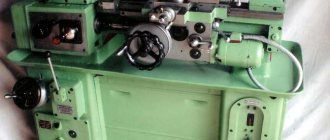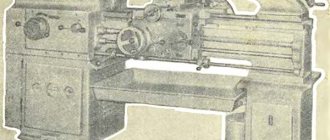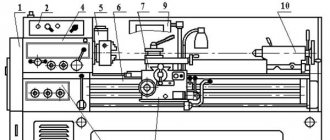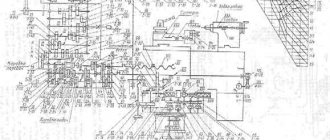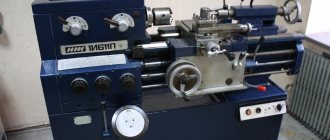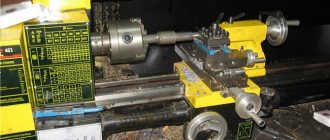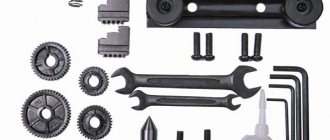The 1K625 screw-cutting lathe was created by the design bureau of the Moscow Machine Tool Plant based on the 1K62 machine. The reason for this was the need in the engineering industry for medium-sized turning equipment capable of processing longer workpieces.
Compared to the base model, all 1K625 variants have increased center dimensions by a third and maximum processing diameters by a quarter. Both machines were produced from the second half of the fifties to the beginning of the seventies and were replaced in the production line by the 16K20 family. 1K625 was produced in three standard sizes and, depending on the equipment, has several modifications.
Purpose and scope of screw-cutting lathe
This device is intended for a number of turning operations:
- cutting metric, pitch, inch and modular threads, as well as Archimedean spirals;
- processing of hardened bearings;
- turning of materials of different types, using shock loads that do not affect the accuracy of processing parts;
- making cuts using carbide tools.
1K625 belongs to the group of frontal lathes, which allows processing short workpieces with large diameters.
Design
The technological solutions used in the manufacture of this model of the machine in its design make it possible to perform a wide range of work with high precision.
Headstock
Located on the left side of the frame, it has the following fixed inside its upper part:
- spindle;
- gearbox
A jaw chuck, which is flanged to the protruding end of the spindle, is used to hold the workpiece before it begins to rotate. The electric motor is installed in the engine compartment, which is located in the lower part of the headstock.
Caliper
The speed of the caliper is set by the transmission setting range. The functions of the support include:
- implementation of transverse feed of the cutter;
- implementation of longitudinal feed of the cutter.
The caliper is driven by an apron mechanism, which is rotated by a shaft (to ensure turning operations) or a lead screw (to perform threading).
Tailstock
The design features of this unit allow processing of flat cones, which is achieved using its transverse displacement. By connecting this assembly and the lower part of the caliper (using a special clamp), you can drill and mechanically move it away from the caliper.
Gearbox
The feed box is fixed on the frame, which is located under the headstock. The box has shafts on which are located:
- Norton mechanism block, stepped (Fig. 12);
- gear blocks 6, 13;
- switchable clutches 1,2,4,5,7,14,15.
Clutch 7, moved to the right position, ensures rotation of the lead screw 9, and the drive shaft 10 begins to rotate when the overrunning clutch 11,12 is switched to the left position.
Apron
The housing directed towards the caliper carriage contains an apron mechanism (Fig. 14):
- worm wheel 3 rotates due to the influence (through a series of gears) of the drive shaft;
- The rotation of shaft I occurs with the help of a gear wheel of the corresponding shafts II and III; couplings with end teeth 2, 4, 10, 11 are located on them.
Clutches with end teeth ensure the process of turning on and moving the caliper in two planes, in four directions:
- for movement in the longitudinal plane it is necessary to use rack and pinion wheel 1;
- for movement in the transverse plane, it is necessary to use a screw that rotates under the influence of a gear wheel.
Handle 8 performs control functions for the lead screw 6 and the nut 7. The lead screw and shaft are locked using a shaft with cams 9.
Important!
This lock prevents the caliper from feeding when turned on at the same time.
Electrical equipment
The purpose of the electrical equipment of the device is aimed at connecting to a three-phase alternating current network equipped with an insulated or solidly grounded neutral wire. Electrical components of the machine:
- control circuit - 50 Hz, 110 V;
- power circuit 3–50 Hz, 380 V, (220 V on special order);
- local lighting circuit - 50 Hz, 36/24 V.
Principle of operation
The operating principle of a lathe is as follows: after assembling, installing and connecting the machine, a workpiece or part is fixed in the designated units, after which the machine is started and work begins, for example, the required amount of material is removed with a cutter.
If necessary, you can use additional equipment (for example, for grinding or drilling), which significantly expands the range of tasks performed by the equipment.
Passport for the machine
The “Technical and Operational Passport” of each screw-cutting lathe 1K625 contains a detailed description of all the technical characteristics of the copy shipped to the customer, including:
- parameters of drives and friction couplings;
- specifications for gears, worm wheels, screws and nuts;
- list and description of control knobs;
- tables of machine time and machine productivity when performing standard operations;
- actual characteristics of accuracy and rigidity;
- list of additions and changes;
- specification for the lubrication scheme;
- specification for the circuit diagram;
- list and description of bearings.
The final part of the “Passport” is the four-page “Certificate of technical testing and acceptance of the machine”, at the end of which the test results are given, confirmed by the signatures of the workshop manager and the head of the quality control department. Appendix N1 lists the accessories and fixtures supplied with the machine, and Appendix N2 contains a list and drawings of wearing parts.
General form
Specifications
This section provides technical characteristics of the machine itself and its individual components and elements.
Main settings
It is allowed to use parts for processing if they do not exceed the following dimensions:
- 500 mm above the bed;
- 260 mm above the caliper;
- 45 mm in the spindle cavity.
In this case, it is permissible to use parts with a length of 1000, 1400, 2000 mm; the specific size depends on the modification of the equipment used.
The machine allows you to cut different types of threads:
- metric threads - 44;
- inch threads - 38;
- modular threads - 20;
- pitch threads - 37;
- Archimedes spiral - 5.
Spindle:
- Diameter of through hole in spindle, mm: 47.
- Largest rod diameter, mm: 45.
- Number of speed steps for direct spindle rotation: 24.
- Direct spindle rotation frequency, rpm: 12.5..2000.
- Number of spindle reverse rotation frequency steps: 12.
- Spindle reverse rotation frequency, rpm: 19..2420.
- Size of the internal cone in the spindle, M: Morse 6.
- Spindle end according to GOST 12593-72: 6K.
Caliper:
- Maximum stroke length of the carriage, mm: 930, 1330, 1920.
- Maximum lateral stroke of the caliper, mm: 300.
- Maximum stroke of the upper support (cutting slide), mm: 150.
- Number of longitudinal feed stages: 49.
- Limits of longitudinal working feeds, mm/rev: 0.07..4.16.
- Number of cross feed stages: 49.
- Transverse working feed limits, mm/rev: 0.035..2.08
- Speed of fast movements of the caliper, longitudinal, m/min: 3.4.
- Speed of fast movements of the caliper, transverse, m/min: 1.7.
- Number of metric threads cut: 44.
- Limits of metric thread pitches, mm: 1..192.
- Number of inch threads to be cut: 38.
- Limits of pitches of cut threads inch: 24..2.
- Number of modular threads to be cut: 20.
- Limits of pitches of cut modular threads: 0.5..48.
- Number of pitch threads to be cut: 37.
- Limits of steps of cut pitch threads: 96..1.
Electrical equipment:
| Type | Model | power, kWt | Node, purpose |
| Electric motor | AO2-52-4F | 10 | main drive |
| Electric motor | AOL2-12-4F | 0,8 | Fast travel |
| Electric motor | AOL2-22-6F | 1,1 | Hydro station |
| Electric motor | PA-22 (pump) | 0,125 | Cooling pump |
In total, the machine is equipped with four electric motors.
Dimensions and weight:
- machine weight (RMC = 1000), t: 2.4
- machine dimensions (length/width/height) (RMC = 1000), mm: 3212x1216x1349
Overall dimensions of the workspace
Dimensional restrictions when processing a product on a lathe depend on its geometric characteristics, the main of which are the value of the center-to-center distance, as well as its height above the lower surface of the support and guides (for machines with a recess, above its lower plane). 1K625 was produced in three options for center-to-center distance with the following maximum restrictions on turning length: 930, 1330, 1920 mm, and the maximum machining height above the guides and the lower surface of the support for all three options is, respectively: 250 and 130 mm.
Regulation
Adjusting device components is a natural workflow that the machine operator must periodically resort to during work. In order to avoid mistakes in this process, it is advisable to have the technical data sheet of the device at hand or ask for advice from more experienced colleagues.
Main drive belt tension
The spindle torque may decrease over time during operation of the machine, which means it is necessary to check the tension of the V-belt drive belts, which goes from the main motor to the friction shaft of the device.
To perform this procedure, you must:
- Remove the lower casing.
- Loosen the wedge pin nut that secures the under-engine plate.
- Lower the stove until the belts have the required tension.
- After finishing work, tighten the nut.
Adjusting the friction multi-plate clutch
If it is necessary to increase the spindle torque with normal belt tension, it is possible to adjust the friction clutch of the main drive. For this:
- The main drive motor turns off.
- The top cover on the headstock is removed.
- The oil distribution tray is removed.
- By turning round nut 2 (Fig. 12), the forward rotation clutch is adjusted; turning nut 3 adjusts the spindle reverse rotation clutch. The nuts can be turned only after the latch 4 is inserted into the ring 5 (Fig. 12).
- Handle 20 (Fig. 5) is moved to the lower position to adjust the forward rotation clutch, to the upper position for reverse rotation; before performing these procedures, it must be moved to the extreme left position (16:1 selection is turned on).
To adjust, it is usually enough to perform 1/12 of a turn, focusing on the grooves that are located along the periphery of the nut (there are 12 of them), and it is necessary to control the movement of the latch into the groove, otherwise the nut may spontaneously unscrew during operation.
If you tighten the clutch fasteners too much, then turning on the handle 20 (Fig. 5) will be difficult. In this case, it is necessary to loosen the nuts.
Adjusting the band brake
The level of tape tension affects the total spindle braking time; the norm is 1.5 seconds when braking the spindle without a fixed workpiece and chuck at 2000 rpm.
If the level of spindle braking is significantly lower than required, it is necessary to adjust the brake by tensioning the brake band 1 (Fig. 13) using nuts 2.
Lever 3 should be located symmetrically to the protrusion of the roller - rack 4 in the locked position of the spindle. Fixation of the roller in a certain position is ensured by a ball 5 with an adjusting spring 6.
Adjusting the spindle bearings
The double row front roller bearing and rear radial thrust bearings are factory preset and do not require further adjustment.
Eliminating the backlash of the caliper transverse movement screw
The backlash level should not be higher than 2 divisions on the dial, while screw 5 should be adjusted in such a way that it can be turned without difficulty by hand.
To sample the backlash:
- lowering screw 1 (Fig. 14) of the left part of nut 2;
- tightening the wedge that is between the nut halves (cut);
- wedge 3 is tightened by screw 4;
- the axial clearance in the screw pair is selected.
Installing the tailstock along the center line
When installing the tailstock strictly along the center line with the center axis of the headstock, it is necessary to align the plane of the plates (Fig. 15), using the corresponding screws No. 1 and No. 2 (Fig. 9).
How to adjust the steady rest lock
Adjustment of the lock of the fixed rest is carried out if the lock of its upper folding part is weakened, which leads to a lack of reliability of fastening of this unit. The procedure itself is carried out according to the instructions noted in the machine passport.
Location and specification of components
The 1K625 screw-cutting lathe is one of the representatives of the class of universal turning equipment and therefore it has a fairly traditional composition and placement of components and assemblies. The basic design of the machine is a cast hollow frame mounted on two (for the longest version, three) massive pedestals. On its upper surface there are four guides: two rectangular and two trapezoidal.
In addition to the bed, the main functional components of the 1K625 machine are:
- Headstock. Located on the left side of the bed. It contains a spindle assembly and a gearbox for switching rotation speeds.
- Tailstock. Located at the right end of the guides. Its main purpose is to support long workpieces and fasten rotary tools.
- Caliper with tool holder. It is the main working unit of the machine, because provides longitudinal and transverse movement of the cutting tool. Moves along guides between the headstocks.
- Lunettes. Mounted on guides. Serve as an intermediate support when turning long workpieces.
Rotation is transmitted to the spindle from the main engine through the gearbox, and to the caliper - from an apron connected by a lead screw and a lead shaft to the feedbox.
Safety precautions at work
Safety standards when using this machine do not differ from generally accepted ones:
- The worker must wear clothes that do not restrict movement, but not too loose, and use safety glasses.
- Use a wooden pallet to protect against electric shock during operation.
- Use the machine's protective cover when working.
see also
- Thread puller from veneer stitching machine MN 1109
CNC plywood cutting machine- Woodworking machine master universal 2500e
- Mobile flange processing machines
- Makita metal cutting machine
- Keyway milling machine 692d
- 3A130 cylindrical grinding machine
- Business on a CNC woodworking machine
Business on a CNC woodworking machine- Machine for the production of expanded clay blocks, do-it-yourself drawings
- Magnetic table for grinding machine
Features of modification 1K625D
The main feature of the modification with the “D” index is the increased processing diameter, up to 1000 and 1500 mm, depending on the selected version of the machine with this index. The maximum processing diameter of the previous modification was 500 mm.
In addition, in the modification with the letter “D” the speed mode of accelerated movement performed by the caliper was exactly doubled; now this parameter corresponds to 4.5 m/minute. The variations of metric and pitch threads have changed significantly, but the number of options for inch threads has decreased.
The main drive received increased power to 11 kW and the weight of the machine increased significantly - up to 3100 kg.
Electrical equipment
Over the many years of production, the electrical circuit of the 1K625 machine has remained virtually unchanged. But since it was produced for almost two decades, the element base of machines from different years can differ significantly. The electrical equipment of the machine has two versions: normal and tropical.
The machine is powered from the following AC sources:
- power circuits - 3 x 380 V (optional - 220 V);
- monitoring and control equipment - 110 V;
- lighting fixtures - 24 or 36 V.
The 1K625 lathe has three types of electrical equipment protection:
- fuse links (from short circuit currents);
- thermal relays (from overloads of electric motors);
- starters with zero protection (against voltage drop).
There are four electric motors on the machine: the main motor, the quick move motor, the hydraulic support pump and the coolant pump. All control and monitoring electrical equipment is mounted in an electrical cabinet, which is installed on the right at the rear of the frame.
The procedure and frequency of inspection and maintenance of electrical equipment 1K625 are described in detail in its “Care and Maintenance Manual”. For example, technical inspection of engines should be carried out at least once every two months, in which case it is necessary to clean the engines from contamination and check the reliability of electrical connections and grounding.
Upgrade options
Usually, the possibility of modernization means the installation of a CNC, but the price of such improvements can reach the price of the device itself. In the case of the 1K625 model, the following components can be modified:
increased power with a more powerful electric motor; adding working gears. In addition, it is possible to mechanize the processes associated with the placement of workpieces, their removal and fastening.
Before installing new components, it is necessary to carefully calculate the feasibility of improving the machine, both from an economic point of view and from the point of view of its performance and resource.
But even without this, the 1K625 model has an excellent combination of reliability and ease of maintenance at the same time as the ability to perform work within the capabilities of the machine while achieving high quality.
Design features of the lathe 1k625
Turning flat cones on a 1k625 lathe is possible due to the features of its design.
Thus, the 1st method of processing conical surfaces requires a transverse displacement of the tailstock housing of the machine. As a result, the longitudinal axis of the workpiece forms an angle with the axis of the centers equal to the value of the taper. The cutter sharpens the forming surface of the cone. This option does not provide high manufacturing accuracy, because The position of the centering holes at the ends of the part is not correct relative to the centers of the headstocks.
The 2nd method is suitable for obtaining cones of small height. To do this, you need to rotate the caliper slide with the cutter to the required angle.
The most convenient way from the point of view of the accuracy of the cone and the absence of restrictions on its height is the use of a ruler-copier. It is fixed to the back of the frame on special brackets at the desired angle to the center axis. A slider moves along the copier with tight contact. It is rigidly connected to the machine support slide using a pin on the guide rod. As a result of the simultaneous combination of longitudinal (carrier) and transverse (slide) movement, the cutter creates a cone surface.
If in the above copying device you use a shaped ruler instead of a conical ruler, the cutting tool will completely repeat its curved shape. In addition, it is possible to use a copying support with a hydraulic drive. Then it becomes possible to turn stepped shafts on the machine.

